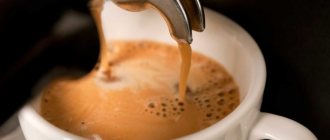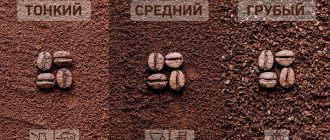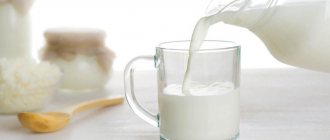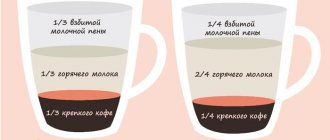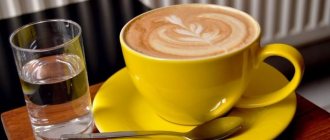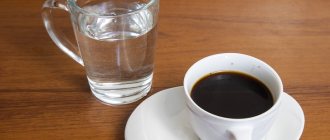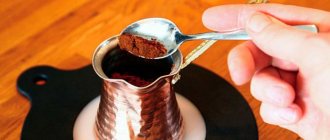How many tablespoons are in a cup?
Measure conversion table
| Cups to Tablespoons Conversion Chart | |
| Cup | Spoons |
| 1 cup | 16 tablespoons |
| ¾ cup | 12 tablespoons |
| ⅔ cup | 10 tablespoons + 2 teaspoons |
Interesting materials:
Where is the head and where is the tail, Ukraine? Where are the baby's first movements felt? Where are the movements felt at 18 weeks? Where did Noah's ark stop? Where did the Normans leave their mark? Where to leave luggage in Domodedovo? Where to leave winter clothes in Vnukovo? Where to relax in the summer in Abkhazia? Where to relax by the sea in the UAE? Where to relax with your family in Krasnoyarsk?
Meaning and origin of the word "mug"
According to information from explanatory dictionaries, a mug is a generalized name for kitchen and tableware that is used for eating, as well as for storing and containing a wide variety of drinks. As a rule, dishes made of glass or ceramics have thick walls and a handle in the form of a bow on the side surface. This design allows you to pour both cold and hot drinks into it.
As for the shape, the vessel most often resembles a cylinder or a truncated cone, but mugs are also available in spherical and ellipsoidal shapes, as well as in the form of various figures (animals, objects, etc.).
Depending on the manufacturer, the capacity of the cutlery varies from 230 to 500 milliliters . However, there are also options that can hold liquid up to one liter. The average capacity of mugs is 250 ml .
The word itself has quite an old origin and dates back to the 15th century and was borrowed from the Polish language, from which “kruz” means jug. In such a vessel, the upper diameter is larger than the lower one, and it itself was made of clay.
What should a tea mug be like?
The first to taste the taste of tea were the Chinese. Even today, along with the Japanese, they are considered the main admirers and producers of this drink. You can’t argue with history, because it was in China that the tradition of the tea ceremony with all the rules that followed from it was formed over centuries. Today in the world, for some, a mug of tea is a reason to get together to communicate and have a good time; for others, it is an opportunity to take a break and cheer up; for others, it is a whole leisurely procedure that requires a special attitude and skills.
In the east there is no concept of a circle. In the sense in which Europeans see it. This is a medium-sized dish with a handle designed for tea or coffee. There they drink tea from bowls without handles with a wide top and a volume of 40-70 ml.
It is believed that it is this container that allows a person to correctly assess the brightness of the aroma, color and taste of the drink. The ideal mug for tea is a 60 ml bowl made of porcelain, white on the inside and with a light, unobtrusive pattern on the outside, often something from natural motifs, so that you can quickly tune in to tea drinking and relax.
The ideal bowl for expensive Chinese green tea
It is traditional to divide tea vessels into:
- Yin;
- Yanskie.
The first are small wide bowls, the second are tall cups, more like glass glasses with straight edges. In Europe, the Yin cup was turned into a Viennese cup, adding a handle for convenience and painting it for chic.
What should tea packaging be like?
How were things in Russia? Among the common people, they drank tea from tin or glass glasses, the volume of which reached 500 ml, because the drink was rather treated as a means that would warm and quench thirst.
Porcelain sets were popular among merchants and other nobility for a nice and long conversation. The volume of the cups in them reached 250-300 ml. During the evening several cups of rolls, bagels and other baked goods could be drunk.
Today, the best vessels for tea are still considered to be porcelain cups, widened at the top. They allow the aroma of the drink to fully develop. A prerequisite is white color. In such a container, you can evaluate the quality of the infusion by the intensity of the color of the water. Second in line is a clay tea cup. It always has thick walls and absorbs odors, so if you drink the same drink from it, it will taste better each time. In winter, it is preferable to drink hot drinks from earthenware, as they stay warm longer. In the summer, they give way to thin-walled porcelain mugs, in which, on the contrary, the liquid cools faster.
Clay is an option for dishes made from environmentally friendly materials
The worst utensils for tea are:
- metal;
- glass;
- plastic.
The first two materials heat up quickly, and you can burn your lips and fingers on the edges of the mugs. Plastic will “enrich” the drink with a bouquet of special aromas that no one will like. If you brew tea with boiling water in it, you can add a whole list of harmful toxins to the beneficial components of tea.
To choose the right mug for tea, you need to learn how to treat this drink correctly. In China, tea is not just a drink, it is something special that gives an incentive to life, restores lost strength, balances emotional experiences, and tunes into harmony with the world and oneself. Historically, tea in China has always been expensive, and small bowls for it supported the idea of \u200b\u200bthe preciousness of this drink. When Europeans learn to perceive tea correctly, they will be able to fully enjoy this drink and get true pleasure even after 2 sips from a tiny bowl.
Measure the volume with a faceted glass (table)
| Volume | Number of faceted glasses to the top (250 ml) | Number of faceted glasses up to the risk (200 ml) |
| 5 liters of water | that's 20 glasses | that's 25 glasses |
| 4 liters of water | that's 16 glasses | that's 20 glasses |
| 3 liters of water | that's 12 glasses | that's 15 glasses |
| 2.5 liters of water | that's 10 glasses | |
| 2 liters of water | that's 8 glasses | that's 10 glasses |
| 1.5 liters of water | that's 6 glasses | |
| 1.2 liters of water | that's 6 glasses | |
| 1 liter of water | that's 4 glasses | that's 5 glasses |
| 750 ml. water | that's 3 glasses | |
| 600 ml. water | that's 3 glasses | |
| 500 ml. water or 0.5 liter | that's 2 glasses | |
| 400 ml. water | that's 2 glasses | |
| 250 ml. water | that's 1 glass | |
| 200 ml. water | that's 1 glass | |
| 100 ml. water | that's 1/2 cup |
Where else are these containers used?
In addition to their intended purpose, mugs are also used in the preparation of various dishes as measuring cups or for storing flour, sugar or cereals. Many housewives have decorative vessels in their kitchens in which they hold cutlery. Speaking about this use of mugs, it is worth noting that often their capacity is at least 500 ml . They can be decorated with decorative elements and are not designed for storing liquids. There are also products that can easily be put on fire without fear of deformation.
Liter containers can be used as flower pots or vases. The use of such metal or glass mugs depends on your imagination and imagination. True, the price of such items can be much higher than their counterparts for their intended purpose. Therefore, if you have an old metal or glass mug lying around, do not rush to get rid of it. Perhaps it will fit perfectly into the interior of the kitchen or living room.
In general, we can say that the direct purpose and relevance of use will be directly proportional to how many ml are in the mug, and the second criterion for choosing a given product will be the material and color. The price will also be important, because for some this type of dishware is a trifle, while others like to sit down in bad weather with their favorite mug and an interesting book, covered with a warm blanket.
Paper cups
Cellulose containers have been used in industry for 100 years. But a boom in production occurred with the development of a private catering network.
Interesting! How to prepare coffee beans correctly
Lightweight, durable material prevents customers from getting burned. This glass costs less than ceramic dishes - 2-5 rubles versus 500-1500 rubles. It’s easy to put a picture or coffee shop logo on the container.
The size of paper cups ranges from 220 ml to 500 ml. Coffee takes up no more than one third of the glass, and the rest is water, milk, ice cream and other additives.
Did you know that such a cup is called demitasse?
Not really
Thermal mugs: at the peak of popularity
Thermal mugs deserve special attention . This dish is a small thermos, the inner walls of which are made of ceramic metal. From the outside, this product resembles a tall metal glass with a lid and a small hole for drinking. Initially, such mugs were used by tourists or military personnel. The storage temperature for drinks can reach up to 8 hours. The capacity of such products ranges from 250 ml to 1 liter.
Now the scope of their application has grown significantly. Mini thermoses are very popular among office workers who spend almost the entire working day at the desk and computer, and do not always have time for drinking tea.
In addition to such thermoses, very common are mugs, the outer side of which can change its color depending on the temperature of the liquid inside. When you pour hot tea or coffee, a design or pattern appears on the mug. As it cools down, the image gradually disappears.
Tableware that combines the functions of a blender and a glass is called blender mugs. Such devices have a small electric motor powered by batteries or batteries, and can easily prepare cocktails or other drinks for you. True, they can hold no more than 350 ml of liquid , since part of the space in the case is occupied by the motor itself.
Purpose of the cup
For each hot liquid drink there is a specific type of cup:
soup or broth - used for serving broths or puree soups. For ease of eating, they are available with one or two handles. Capacity from 320 – 430 ml.
for tea there are two types: standard and tasting volume.
The standard includes dishes with an average volume of 200 ml.
For tasting - a small cup used for drinking green or black tea with a high degree of brewing.
Coffee houses differ from tea houses in a variety of types:
An espresso cup has a minimum volume of 35 – 40 ml.
What size latte?
Latte portion
served in an Irish glass (240-360 ml) and, accordingly, has a larger
volume
than cappuccino, which is served in cups (150-180 ml).
Interesting materials:
How to enter Valberis? How to log into Vikings via Facebook? How to access YouTube via Google? How to log into VKontakte from Ukraine? How to order MB on Velcom? How to partner with YouTube? How to pin File Explorer to the taskbar? How to pin a window in Google Chrome? How to pin a post on Facebook? How to add an extension to Google Chrome?
How many ml and grams are in a faceted glass of water?
The first faceted glass was produced on September 11, 1943, at the Gus-Khrustal plant. Thanks to the shape of the glass, which gave the glass additional strength and ease of washing the glass in the dishwasher. The cut glass was used in railway transport and in all canteens of the USSR. The size of a standard faceted glass is 55 millimeters in diameter and 73 millimeters in height. Then faceted glasses began to be produced in different sizes: 50, 100, 150, 200, 250 and 350 milliliters. The cost of a standard faceted glass depended on the number of faces. Glasses with 10, 12, 14, 16, 18 and 20 sides were produced. The first faceted glasses had 10 sides and cost 3 kopecks. Classic 16-sided - 7 kopecks, and if more grooved, with 20 edges, then 14 kopecks. But the capacity of the glass remained unchanged: to the glass rim - 200 ml, to the brim - 250 ml .
Review of services for coffee ceremonies
We invite you to evaluate the beauty and functionality of several sets selected for us in online stores.
A typical representative of a timeless classic is a porcelain coffee service of 15 pieces for 6 people. Includes 6 cups and saucers, coffee pot, milk jug, sugar bowl. The highlight is the square shape. Manufacturer: Leander, Czech Republic, “Bianca” series with a characteristic silver stripe. In the same series, the manufacturer produces other tableware.
The “Nostalgia” Turkish coffee set includes 4 0.2 l cups with saucers. The volume of the cezve is 0.7 l. Material – glazed ceramics.
Rocaille coffee service in Rococo style for 6 persons. The set additionally includes 6 dessert plates. Material: hard porcelain. Manufacturer: Germany, KPM Berlin.
The Chinelli coffee set is suitable for lovers of true luxury. The set includes white ceramic cups, brass saucers and cup holders, steel coffee spoons, and a brass sugar bowl. Sold in a beautiful gift box.
How many ml and grams in a glass of water?
Before we answer the question of how much water is in a glass (ml and grams), we must understand that glasses are all different. Today, glasses are made from cardboard, plastic, glass, metal and clay. Each glass plays its role. There are glasses for juice, beer, cocktails and other drinks. The glasses are also disposable. Naturally, you need to understand that each glass has its own shape. The glasses that are made for certain drinks differ in volume. But now we will talk about standard glasses that have a standard volume. It is believed that the standard volume of a glass is 200-250 ml .
How many grams of water are in a glass?
In a full faceted glass of water 250 grams
In a faceted glass filled to the rim with 200 grams of water
How many milliliters of water are in a glass?
A full faceted glass contains 250 milliliters of water.
In a faceted glass filled to the rim with 200 milliliters of water
- 1 5 glasses of water is 50 milliliters
- 1 4 glasses of water is 62.5 milliliters
- 2 3 glasses of water is 166.7 milliliters
- 1 2 glasses of water is 125 milliliters
- 1 3 glasses of water is 83.3 milliliters
- 3 4 glasses of water is 187.5 milliliters
- 4 5 glasses of water is 200 milliliters
- 2 glasses of water is 500 milliliters
- 3 glasses of water is 750 milliliters
- 4 glasses of water is 1 liter of water
- 5 glasses of water is 1250 milliliters of water
| Type of glass | Capacity in milliliters | Capacity in grams |
| How much water is in a cut glass (to the brim) | 250 ml. (to the brim) | 250 grams (to the edges) |
| How much water is in a faceted glass (before risks) | 200 ml. (before risks) | 200 grams (before risks) |
| How much water is in a regular glass | 250 ml. | 250 grams |
| How much water is in a tea glass | 250 ml. | 250 grams |
| How much water in a juice glass | 200 ml. | 200 grams |
| How much water is in a beer glass | 500 ml. | 500 grams |
| How much water is in a regular white disposable cup? | 180 ml. | 180 grams |
| How much water is in a regular glass? | 50 ml. | 50 grams |
Attention! For all recipes, 200 ml . glass as a measure of one glass. Recipes often say to add 1 cup of flour. This means that the glass should be 200 ml.
What does volume depend on?
The volume is influenced by two main parameters - shape and purpose. The balance of characteristics is fundamental for the manufacturer and the buyer. The volume of the mug can vary from 0.03 to 1 liter. Much depends on how and where the container will be used. The standard capacity is 250 ml.
Form
The volume directly depends on the size of the mug and its shape. If the container has a standard cylinder shape, its capacity will be maximum. When the dishes have all kinds of contractions, expansions, and transitions, this parameter decreases. The larger the shape of the container, the smaller its volume.
There are 2 main shapes of a mug. The glass-shaped one has an elongated body, so at a significant height it holds little liquid. Pial-shaped is distinguished by a spherical shape, which is slightly narrowed downwards. The larger the volume, the wider the vessel.
An elongated mug holds more liquid
Pial-shaped less spacious
Purpose
The volume of the cup is determined by the purpose, according to which manufacturers think through the following parameters:
- metal and plastic specimens are often used on hikes and in everyday life, so their volume is usually 250-300 ml. There is a liter mug for certain tasks;
- porcelain and ceramic options are rarely used. They serve more as a decoration for an exquisite tea party, so they hold no more than 200 ml of liquid;
- containers that are used in everyday life for cold and hot drinks can have a capacity of 250 to 420 ml;
- blender mugs are suitable for certain manipulations with liquids, so the parameters can be equivalent to a half-liter jar;
- bouillon cups are designed for serving soups, have two handles and hold from 250 to 650 ml;
- Thermal mugs are used as containers for food or drink. The capacity of such dishes can reach 0.7 liters.
When choosing a mug, it is worth considering that its filling capacity will be less than its actual volume.
Plastic mugs for hiking – 300 ml
Porcelain mug – 150 ml
Drink containers – 400 ml
Blender mug – 450 ml
Broth mug – 500 ml
Thermo mug – 700 ml
What should a tea mug be like?
The first to taste the taste of tea were the Chinese. Even today, along with the Japanese, they are considered the main admirers and producers of this drink. You can’t argue with history, because it was in China that the tradition of the tea ceremony with all the rules that followed from it was formed over centuries. Today in the world, for some, a mug of tea is a reason to get together to communicate and have a good time; for others, it is an opportunity to take a break and cheer up; for others, it is a whole leisurely procedure that requires a special attitude and skills.
In the east there is no concept of a circle. In the sense in which Europeans see it. This is a medium-sized dish with a handle designed for tea or coffee. There they drink tea from bowls without handles with a wide top and a volume of 40-70 ml.
It is believed that it is this container that allows a person to correctly assess the brightness of the aroma, color and taste of the drink. The ideal mug for tea is a 60 ml bowl made of porcelain, white on the inside and with a light, unobtrusive pattern on the outside, often something from natural motifs, so that you can quickly tune in to tea drinking and relax.
The ideal bowl for expensive Chinese green tea
It is traditional to divide tea vessels into:
- Yin;
- Yanskie.
The first are small wide bowls, the second are tall cups, more like glass glasses with straight edges. In Europe, the Yin cup was turned into a Viennese cup, adding a handle for convenience and painting it for chic.
What should tea packaging be like?
How were things in Russia? Among the common people, they drank tea from tin or glass glasses, the volume of which reached 500 ml, because the drink was rather treated as a means that would warm and quench thirst.
Porcelain sets were popular among merchants and other nobility for a nice and long conversation. The volume of the cups in them reached 250-300 ml. During the evening several cups of rolls, bagels and other baked goods could be drunk.
Today, the best vessels for tea are still considered to be porcelain cups, widened at the top. They allow the aroma of the drink to fully develop. A prerequisite is white color. In such a container, you can evaluate the quality of the infusion by the intensity of the color of the water. Second in line is a clay tea cup. It always has thick walls and absorbs odors, so if you drink the same drink from it, it will taste better each time. In winter, it is preferable to drink hot drinks from earthenware, as they stay warm longer. In the summer, they give way to thin-walled porcelain mugs, in which, on the contrary, the liquid cools faster.
Clay is an option for dishes made from environmentally friendly materials
The worst utensils for tea are:
- metal;
- glass;
- plastic.
The first two materials heat up quickly, and you can burn your lips and fingers on the edges of the mugs. Plastic will “enrich” the drink with a bouquet of special aromas that no one will like. If you brew tea with boiling water in it, you can add a whole list of harmful toxins to the beneficial components of tea.
To choose the right mug for tea, you need to learn how to treat this drink correctly. In China, tea is not just a drink, it is something special that gives an incentive to life, restores lost strength, balances emotional experiences, and tunes into harmony with the world and oneself. Historically, tea in China has always been expensive, and small bowls for it supported the idea of \u200b\u200bthe preciousness of this drink. When Europeans learn to perceive tea correctly, they will be able to fully enjoy this drink and get true pleasure even after 2 sips from a tiny bowl.
Preferences in different situations
Countries and connoisseurs
In Russia, a coffee cup with a volume of 100-130 ml is in demand, which is considered large in Europe and Asia. In the USA, they prefer to drink from impressive containers up to 180 ml, and cappuccino and latte - up to 350 ml.
Coffee gourmets prefer half-shaped containers called dmitas. They hold 60 ml of natural coffee. They pour coffee drinks into glasses up to 250 ml.
Which cups do you most often drink coffee from?
up to 130 mlot 130 and above
For home and office
To make coffee at home, coffee lovers use ceramic mugs of their favorite color with a volume of 170 to 220 ml. These sizes allow you to pour cappuccino, latte, mocha. The main thing is that there is a comfortable handle that allows you to hold a hot cup in your hands.
For work or the office, buy medium-sized containers of 150-170 ml, which are versatile. They are also used for tea, juices, and water. Preference is given to pleasant pastel colors that do not irritate.
For a coffee shop
Cafe owners choose cups of at least three sizes:
- 50-90 ml - for serving ristretto, espresso;
- 170-220 ml - for cappuccino, latte, Americano;
- up to 350 ml – for coffee cocktails.
If you buy mugs from one supplier, you can negotiate a discount. Another plus is that the same dishes will emphasize the style of the coffee shop.
Characteristics of the mug
In the classic version, it is a cylindrical vessel, complemented by a comfortable handle. You can drink cold and hot liquids from such dishes. The standard characteristics of a mug can be expanded if we consider what material it is made of and what shape it has. The volume may also vary depending on the purpose of the product.
The manufacturing material can be:
- porcelain - the cup maintains the temperature of the drink for a long time, and does not heat up at all. The material looks impressive, but it is very fragile and expensive;
- earthenware is an excellent analogue to porcelain, but the mug looks rougher - its walls are thicker. Considered ideal for home use;
- ceramics – has all the advantages of porcelain. Dishes made from such material are not very attractive, they quickly wear out and deteriorate, but they are cheap;
- glass is a modern alternative to all of the above options. The cup cools down quickly, and so does the drink itself. The vessels have an original, varied design. The price is affordable;
- glass ceramics – there are no pores in the walls of such dishes, so the products are very durable, retain heat well, and are easy to clean;
- metal: silver, stainless steel, copper, aluminum - silver mugs look elegant, but are not suitable for everyday use. Silver darkens quickly and requires careful care to maintain its shine. Copper mugs are beautiful and have an interior lining of another metal. Suitable for festive occasions or daily use. Stainless steel mugs are resistant to mechanical damage and do not require special care. A great option for every day. Aluminum products are purchased mainly as a traveling option. This mug is light in weight and can be used to boil water if necessary. The type of metal determines the cost of the product.
Glass cups are unacceptable for coffee, as the drink loses its taste and aroma. The modern material for making tableware is plastic. It is used to make camping mugs, thermal mugs, and children's dishes. Plastic products are convenient because they do not break and weigh little. Decorative cups are made of wood and stone.
PorcelainFaienceGlass ceramicsMetalGlassCeramics
